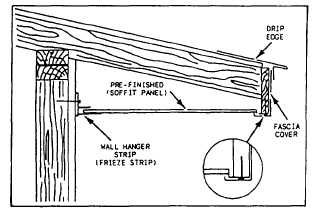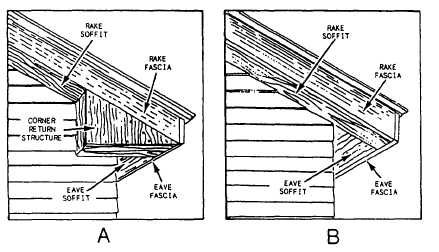Figure 3-11.-Cornice construction: A. Finish rake for boxed cornice; B. Rake soffit of a sloped box cornice.
The flat boxed cornice requires framing pieces
called lookouts. These are toenailed to the wall or to a
lookout ledger and face-nailed to the ends of the rafters.
The lookouts provide a nailing base for the soffit, which
is the material fastened to the underside of the cornice.
A typical flat boxed cornice is shown in figure 3-10,
view A. For a sloped boxed cornice, the soffit material
is nailed directly to the underside of the rafters (fig. 3-10,
view B). This design is often used on buildings with
wide overhangs.
The basic rake trim pieces are the frieze board, trim
molding, and the fascia and soffit material. Figure 3-11,
view A, shows the finish rake for a flat boxed cornice.
It requires a cornice return where the cave and rake
soffits join. View B shows the rake of a sloped boxed
cornice. Always use rust-resistant nails for exterior
finish work. hey may be aluminum, galvanized, or
cadmium-plated steel.
PREFABRICATED WOOD
AND METAL TRIM
Because cornice construction is time-consuming,
various prefabricated systems are available that provide
a neat, trim appearance. Cornice soffit panel materials
include plywood, hardboard, fiberboard, and metal.
Many of these are factory-primed and available in a
variety of standard widths (12 to 48 inches) and in
lengths up to 12 feet. They also maybe equipped with
factory-installed screen vents.
When installing large sections of wood fiber panels,
you should fit each panel with clearance for expansion.
Nail 4d rust-resistant nails 6 inches apart along the edges
and intermediate supports (lookouts). Strut nailing at the
end butted against a previously placed panel. First, nail
the panel to the main supports and then along the edges.
Drive nails carefully so the underside of the head is just
flush with the panel surface. Remember, this is finish
work; no hammer head marks please. Always read and
follow manufacturer’s directions and recommended
installation procedures. Cornice trim and soffit systems
are also available in aluminum and come in a variety of
prefinished colors and designs.
Soffit systems made of prefinished metal panels and
attachment strips are common. They consist of three
basic components wall hanger strips (also called frieze
strips); soffit panels (solid, vented, or combination); and
fascia covers. Figure 3-12 shows the typical installation
configuration of the components. Soffit panels include
a vented area and are available in a variety of lengths.
Figure 3-12.-Basic components of prefinished metal soffit
system.
3-10





